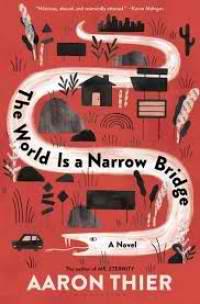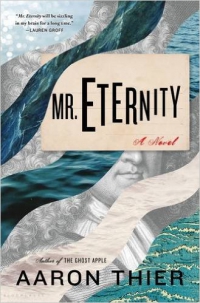The World Is a Narrow Bridge by Aaron Thier
 Wednesday, October 17, 2018 at 7:31AM
Wednesday, October 17, 2018 at 7:31AM 
Published by Bloomsbury on July 3, 2018
The World Is a Narrow Bridge is surprising, funny, and a delight to read. The story is bizarre, the surrealistic stuff of fantasy, yet it is told in such a matter-of-fact style and follows such charming characters (if you don’t count Yahweh) that it all seems very real. In the 21st century, the book teaches, we take our prophets where we can find them, although most of us only listen to the prophets who tell us what we already believe.
Murphy and Eva live in Miami and have no prospect of finding real jobs. Eva is a secular humanist and ill-suited for visits by Yahweh, who wants her to travel around saying the Lord’s name and persuading others to do the same. Eva declines until, seeing Yahweh behind the wheel of a Lamborghini, she realizes she needs a break. A road novel follows. In fact, the story discusses other road novels, including On the Road and Huckleberry Finn and (rather improbably) Moby-Dick. The path Murphy and Eva follow (dictated by Yahweh) seems aimless and drifting, which Eva regards as a metaphor for the life she shares with Murphy.
The road trip yields a long string of funny moments, including Murphy’s realization that he and Eva have decided to have a baby, although he can’t quite recall making that decision, and knows he will eventually recall, not the moment that the decision was made, but “the moment when he realized that he didn’t notice the moment when they decided to have a baby.” I also enjoyed Eva’s observation of how models walk with “head and face absolutely still, chin lifted, eyes closed, lips pressed together in a rictus of neutral sensuality.” During the road trip, Eve and Murphy explore “the geography of hope” (Wallace Stegnar’s phrase), as opposed to “the geography of realistic expectations.” Those examples give a flavor of the humor and clever prose that pervades The World Is a Narrow Bridge.
Yahweh apparently has no policy goal beyond recognition as the one true God. Satan, on the other hand (who bears a striking resemblance to Salman Rushdie) is all about undermining Yahweh. Murphy and Eva aren’t sure which one is preferable, although the get a bundle of money from Yahweh that they are supposed to use to acquire a trash mountain and convert it into a temple of worship.
The World Is a Narrow Bridge is a novel of digressions. Eva and Murphy visit Eva’s family in North Carolina (no questions are asked in the family home “because everyone knows that if you ask questions, you’re likely to get answers that upset you”), but after that, their trip is a long meander. Their conversations are the same. One topic leads to another and then another. The story is full of factoids about buffalo and Bible verses and movie plots and the decay of small Midwestern towns and precipitation averages in semiarid climates. Murphy and Eva made frequent observations about the sameness of life as they make their road trip — the same Super 8 rooms that might just be a memory of the last Super 8 rooms; the same sports clichés echoed by basketball players before each playoff game — but they also ponder the “huge intractable Why of it all” and other mysteries of life: Is Heaven a place beyond the memory horizon, where new memories are not formed, but each moment is “a sweet memory of itself”? If God exists, how does one live a good life, despite all the evil God creates or tolerates? Is goodness in the service of a divine being (as opposed to goodness for its own sake) a form of moral abdication?
The book makes note of profound questions of free will and accountability — if free will exists, we are responsible for our own awfulness, making it more comforting to blame God for making us in His violent image — but it recognizes that the questions are unanswerable, or at least that no answer is capable of proof, making this whole business of living and thinking a frustrating exercise. Ultimately, trying to understand the big picture, or even most small pictures, is futile, because we lack sufficient verifiable data to permit rational conclusions. And while it is often said that everyone is entitled to their opinion, the book suggests that opinions are based on the responsible consideration of available facts, and that opinions based on prejudice or poor information are not opinions at all. “When in doubt, laugh” is the healthy message I take from The World Is a Narrow Bridge.
RECOMMENDED
